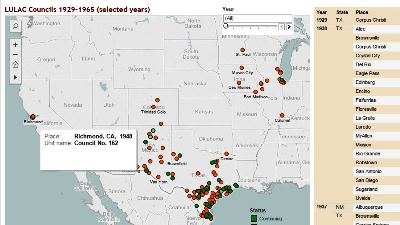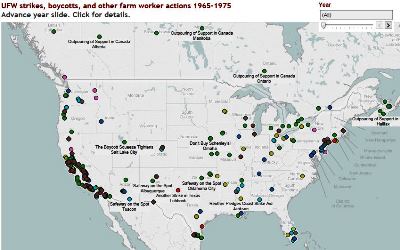Chicano/Latino Movements History and Geography

Mexican Americans have fought for rights, dignity, and cultural freedom since 1846. In the 20th century the fight took new forms. Founded in 1929 and modeled after the NAACP, LULAC and later the Mexican American Legal Defense Fund and the American GI Forum operated as classic civil rights organizations, using persuasion and legal action to defend Mexican Americans. New organizations emerged in the 1960s changing goals as well as tactics, identifying with the label "Chicano" instead of "Mexican American," embracing cultural pride and sometimes militant agendas. [read more]
Here we explore the historical geography of many different organizations in 32 maps and charts, including United Farm Workers 1965-1975, MEChA and Chicano Student organizations 1967-2012; Spring 2006 Immigrant Rights protests; Raza Unida Party 1970-1974; Brown Berets 1967-1972; Chicano Newspapers 1966-1979. Other maps track the activism of earlier generations: LULAC 1929-1977; American GI Forum 1948-1974. This section has been researched and written by Josue Estrada and supported by the Digital History Initiative, History Department, University of Washington.
|
LULAC has represented Mexican Americans since 1929, making it one of the nation's oldest surviving Latino civil rights organization. Founded in Corpus Christi in 1929, LULAC expanded first in Texas. Victory in a precedent-setting 1945 lawsuit challenging segregation of Mexican American students in Orange County, California, helped the organization grow. By 1977, LULAC had chapters in 21 states. |
|
When ethnic Mexican farm workers led by Cesar Chavez joined with Filipino American workers led by Larry Itliong in 1965 to strike grape growers in Delano, California, the modern farm workers' movement was born. Here we map more than 1000 strike actions, boycotts, and other UFW related events showing the movement's support across the United States and Canada. |
|
Chicano students began to organize on college campuses in the late 1960s, forming organizations with various names. In 1969 most of these organizations merged forming El Movimiento Estudiantil Chicano/a de Aztlan (MEChA). Most social movement organizations last only a few years and that is especially true for student run organizations. But MEChA has been active on some campuses for nearly fifty years and the organization continues to grow, with more than 500 chapters as of 2012. |
|
Between February 14 and May 1, 2006, some four hundred protest actions in defense of immigrant rights took place in more than two hundred U.S. cities and towns, involving an estimated six million participants. These events were part of a mass mobilization in response to a draconian immigration bill, the "Border Protection, Antiterrorism, and Illegal Immigration Control Act" (HR 4437) that passed the House of Representatives in December 2015. Catching journalists by surprise, demonstrations rolled across the country. |
|
The Chicano press served as a medium to learn Chicano history, literature, as well as current news and politics. We have located and mapped more than 300 publications. Many were tiny, printing only a few issues and folding in a year or less. Others were much more influential, like El Macriado, the monthly published by the United Farm Workers union or El Grito del Norte from Denver and Caracol from San Antonio. Notice how many communities, large and small, hosted Chicano periodicals (155). |
|
Following the so-called “Chicano takeover” of Crystal City’s school board and city council in 1970, activists launched Raza Unida Party, running candidates in local and state elections in Texas and several other states. These maps show the growth and decline of RUP chapters and electoral campaigns. |
|
In the barrios of Los Angeles, Chicano youth founded the Brown Berets in 1967, modeled after the Black Panther Party. The organization was dedicated to combatting police brutality and racism but some chapters also demanded education, job, and housing equality. By 1969, there were 29 chapters mostly in California but units developed in Colorado, Michigan, Minnesota, New Mexico, Texas and Washington.
. |
By Josue Estrada
Scholars have paid some attention to the geography of Chicano activism but not in the detail that now becomes possible with the maps this project provides. This essay offers important observations while introducing the key organizations of the Chicano movement.
|



